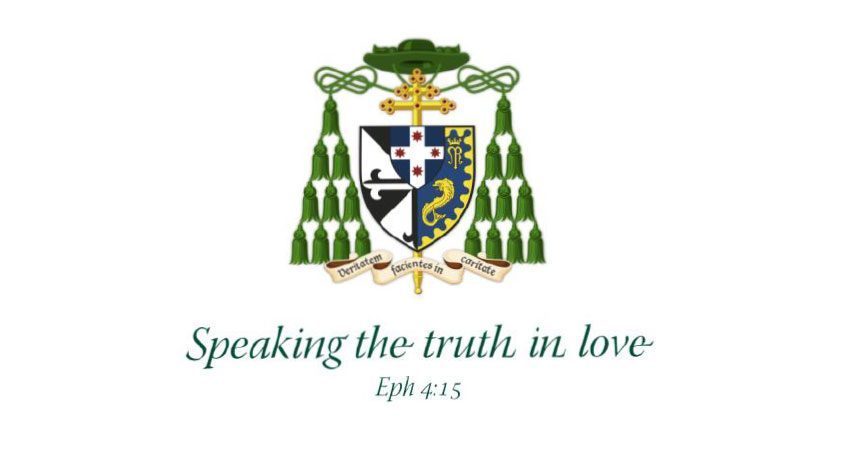PAPAL AWARDS 2021

St Mary’s Cathedral House, Sydney
‘Take me for your model, as I take Christ.’ These words of St Paul give us a template for the Christian life (1Cor 10:31-11:1). St Paul stands as a reflection of the grace of our Lord Jesus Christ, of the love of God, and of the communion of the Holy Spirit (cf. 2Cor 13:3), pointing our gaze towards the source of that grace, love and fellowship.
As we take St Paul as a model, or any of the other saints, and try in turn to be good role models to others, we are obviously not trying to be the same as St Paul or the others. Paul was in fact a flawed man in many ways: proud, status conscious, a regular whinger, and he drove away everyone who worked with him. But we do strive to be like him in the relevant respects, that is in the ways he models Christ for us. It is, as Paul himself insisted, Christ to whom we seek to conform ourselves, not Peter or Paul or Apollos (1Cor 1:10-17; cf. Rom 8:29; 2Cor 3:18). We seek to “put on Christ” (Gal 3:27; Rom 13:14; cf. 2Cor 5:17), to think as He thought (Rom 12:1-2; 1Cor 2:16; Eph 1:17-18; Col 3:1-25; Phil 2:5), to love as He loved (Mt 10:40; Jn 15:12; Rom 15:7; Eph 5:1-2,25; 1Jn 3:23), to serve as He served (Lk 10:37; 22:27; Jn 13:13-17; Eph 5:29), to live as He lived (Eph ch. 4), so that ultimately “It is no longer I who live, but Christ who lives in me” (Gal 2:20; cf. Jn 3:30; 15:1-8; Rom 8:29-30; Gal 4:19; Phil 1:21).
Back in the 1960s the great sociologist Peter Berger coined the term ‘plausibility structures’ – structures of family, friends, institutions and cultural practices that contribute to the plausibility and durability of particular beliefs. In the past, he observed, religion had very strong plausibility structures: it was supported by extended family, ethnic group, neighbourhood, school, civil law and social customs. When I was a child, for example, Sunday churchgoing was supported by Sabbatarian laws and customs that meant:
- hardly anyone worked on Sundays – except emergency workers and priests
- almost all shops were closed on Sundays – apart from corner shops for essentials
- there were few newspapers and practically no sports played
- there was only limited public transport and public entertainments.
This sounds to the contemporary ear as terribly confining, but it reflected a world that prioritized churchgoing on Sunday, where you met your family, friends and neighbours there, before commonly celebrating the family roast together. Normalising churchgoing provided a source of identity and a social glue.
In such a world, taking Christ and His saints as models and modelling that for others was not so difficult or exceptional. But today the plausibility structures that enabled that have largely gone. Nowadays many work on Sundays, shops and entertainments are open for business, sports teams expect you to play, and if you go to church you might not meet many of your relatives, friends or neighbours there.
Which brings me four of our relatives, friends and colleagues today invested with papal honours. They are all examples of people who have taken that model of Christ to heart, sought in their own way to conform themselves to His image, and not shirked their duty to be a model in turn to others. They have contributed much to the Church in Sydney and beyond, and to the wider community, over many years. Not for them the old adage ‘do as I say, not as I do’: no, they have done as they ought, and dedicated themselves thinking after the mind of Christ, loving after His Sacred Heart, serving after the pattern of His service. They have supported ‘plausibility structures’ to support others in our faith, with diverse contributions in the fields of:
- Family life – as spouse, parent and grandparent
- Civic life – as lawyer, coroner, judge, composer, musician, diplomatic family member or pro-life activist
- Ecclesiastical life – as canonist, historian, Thomas More Society member, composer of sacred music, promoter of Christian arts and crafts, agent of vocations or contributor to World Youth Day 2008
- Parish life – in service of the liturgy and sanctuary, pastoral care of the sick and housebound, as parish councillor, sacramental program leader, state school catechist or spiritual formator of lay people
- Devotional life – by promoting Eucharistic Adoration, the Rosary or sacred music
- As members of societies – the Equestrian Order of the Holy Sepulchre, the Society for Eucharistic Adoration, the Thomas More Society, Right to Life, the Legion of Mary and the Serra Club
What a list of contributions from only four people! What diverse models they have been, but each faithful to the image of Christ!. Yet again I’m struck by the extraordinary gifts of the faithful of Sydney and their generosity. I congratulate them on receiving these much deserved awards from Pope Francis. And I join the Holy Father in thanking them for their service and for their witness.

